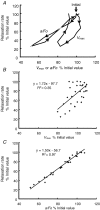Change in contractile properties of human muscle in relationship to the loss of power and slowing of relaxation seen with fatigue
- PMID: 16916911
- PMCID: PMC1890410
- DOI: 10.1113/jphysiol.2006.116343
Change in contractile properties of human muscle in relationship to the loss of power and slowing of relaxation seen with fatigue
Abstract
Slow relaxation from an isometric contraction is characteristic of acutely fatigued muscle and is associated with a decrease in the maximum velocity of unloaded shortening (V(max)) and both these phenomena might be due to a decreased rate of cross bridge detachment. We have compared the change in relaxation rate with that of various parameters of the force-velocity relationship over the course of an ischaemic series of fatiguing contractions and subsequent recovery using the human adductor pollicis muscle working in vivo at approximately 37 degrees C in nine healthy young subjects. Maximal isometric force (F(0)) decreased from 91.0 +/- 1.9 to 58.3 +/- 3.5 N (mean +/- s.e.m.). Maximum power decreased from 53.6 +/- 4.0 to 17.7 +/- 1.2 (arbitrary units) while relaxation rate declined from -10.3 +/- 0.38 to -2.56 +/- 0.29 s(-1). V(max) showed a smaller relative change from 673 +/- 20 to 560 +/- 46 deg s(-1) and with a time course that differed markedly from that of slowing of relaxation, showing very little change until late in the series of contractions. Curvature of the force-velocity relationship increased (a/F(0) decreasing from 0.22 +/- 0.02 to 0.11 +/- 0.02) with fatigue and with a time course that was similar to that of the loss of power and the slowing of relaxation. It is concluded that for human muscle working at a normal physiological temperature the change in curvature of the force-velocity relationship with fatigue is a major cause of loss of power and may share a common underlying mechanism with the slowing of relaxation from an isometric contraction.
Figures




Similar articles
-
Changes in the force-velocity relationship of fatigued muscle: implications for power production and possible causes.J Physiol. 2010 Aug 15;588(Pt 16):2977-86. doi: 10.1113/jphysiol.2010.190934. Epub 2010 Jun 14. J Physiol. 2010. PMID: 20547674 Free PMC article. Review.
-
The measurement of force/velocity relationships of fresh and fatigued human adductor pollicis muscle.Eur J Appl Physiol Occup Physiol. 1999 Sep;80(4):386-93. doi: 10.1007/s004210050608. Eur J Appl Physiol Occup Physiol. 1999. PMID: 10483811 Clinical Trial.
-
Temperature effect on the force/velocity relationship of the fresh and fatigued human adductor pollicis muscle.Pflugers Arch. 2000 May;440(1):163-70. doi: 10.1007/s004240000284. Pflugers Arch. 2000. PMID: 10864011 Clinical Trial.
-
Changes of the force-velocity relation, isometric tension and relaxation rate during fatigue in intact, single fibres of Xenopus skeletal muscle.J Muscle Res Cell Motil. 1994 Jun;15(3):287-98. doi: 10.1007/BF00123481. J Muscle Res Cell Motil. 1994. PMID: 7929794
-
Acute effects of muscle fatigue and recovery on force production and relaxation in endurance, power and strength athletes.J Sports Med Phys Fitness. 1990 Mar;30(1):5-12. J Sports Med Phys Fitness. 1990. PMID: 2195236 Review.
Cited by
-
Understanding altered contractile properties in advanced age: insights from a systematic muscle modelling approach.Biomech Model Mechanobiol. 2023 Feb;22(1):309-337. doi: 10.1007/s10237-022-01651-9. Epub 2022 Nov 6. Biomech Model Mechanobiol. 2023. PMID: 36335506 Free PMC article.
-
Maximal muscular power: lessons from sprint cycling.Sports Med Open. 2021 Jul 15;7(1):48. doi: 10.1186/s40798-021-00341-7. Sports Med Open. 2021. PMID: 34268627 Free PMC article. Review.
-
Exploring the torque- velocity relationship in postmenopausal women: Analyzing the influence of data processing.PLoS One. 2025 Jun 30;20(6):e0327381. doi: 10.1371/journal.pone.0327381. eCollection 2025. PLoS One. 2025. PMID: 40587528 Free PMC article.
-
The molecular basis of frictional loads in the in vitro motility assay with applications to the study of the loaded mechanochemistry of molecular motors.Cytoskeleton (Hoboken). 2010 May;67(5):273-85. doi: 10.1002/cm.20441. Cytoskeleton (Hoboken). 2010. PMID: 20191566 Free PMC article.
-
Muscle contractile properties of cancer patients receiving chemotherapy: Assessment of feasibility and exercise effects.Scand J Med Sci Sports. 2020 Oct;30(10):1918-1929. doi: 10.1111/sms.13758. Epub 2020 Aug 2. Scand J Med Sci Sports. 2020. PMID: 32599670 Free PMC article. Clinical Trial.
References
MeSH terms
Substances
LinkOut - more resources
Full Text Sources

